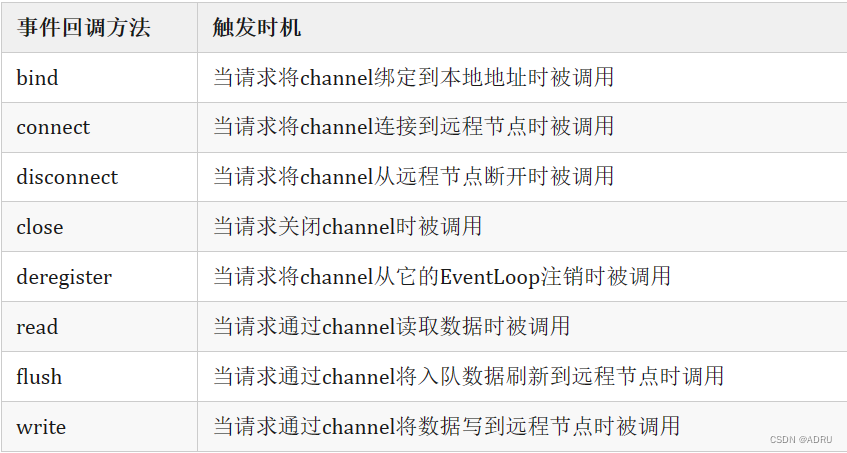调度器详解
前面我们讲过NIO多路复用的设计模式之Reactor模型,Reactor模型的主要思想就是把网络连接、事件分发、任务处理的职责进行分离,并且通过引入多线程来提高Reactor模型中的吞吐量。其中包括三种Reactor模型
-
单线程单Reactor模型
-
多线程单Reactor模型
-
多线程多Reactor模型
在Netty中,可以非常轻松的实现上述三种线程模型,并且Netty推荐使用主从多线程模型,这样就可以轻松的实现成千上万的客户端连接的处理。在海量的客户端并发请求中,主从多线程模型可以通过增加SubReactor线程数量,充分利用多核能力提升系统吞吐量。
Reactor模型的运行机制分为四个步骤:
-
连接注册,Channel建立后,注册到Reactor线程中的Selector选择器
-
事件轮询,轮询Selector选择器中已经注册的所有Channel的I/O事件
-
事件分发,为准备就绪的I/O事件分配相应的处理线程
-
任务处理,Reactor线程还负责任务队列中的非I/O任务,每个Worker线程从各自维护的任务队列中取出任务异步执行。
EventLoop事件循环
在Netty中,Reactor模型的事件处理器是使用EventLoop来实现的,一个EventLoop对应一个线程,EventLoop内部维护了一个Selector和taskQueue,分别用来处理网络IO事件以及内部任务
EventLoop基本应用
下面这段代码表示EventLoop,分别实现Selector注册以及普通任务提交功能。
public class EventLoopExample {public static void main(String[] args) {EventLoopGroup group=new NioEventLoopGroup(2);System.out.println(group.next()); //输出第一个NioEventLoopSystem.out.println(group.next()); //输出第二个NioEventLoopSystem.out.println(group.next()); //由于只有两个,所以又会从第一个开始//获取一个事件循环对象NioEventLoopgroup.next().register(); //注册到selector上group.next().submit(()->{System.out.println(Thread.currentThread().getName()+"-----");});}
}EventLoop是一个Reactor模型的事件处理器,一个EventLoop对应一个线程,其内部会维护一个selector和taskQueue,负责处理IO事件和内部任务。IO事件和内部任务执行时间百分比通过ioRatio来调节,ioRatio表示执行IO时间所占百分比。任务包括普通任务和已经到时的延迟任务,延迟任务存放到一个优先级队列PriorityQueue中,执行任务前从PriorityQueue读取所有到时的task,然后添加到taskQueue中,最后统一执行task。
EventLoop如何实现多种Reactor模型
-
单线程模式
EventLoopGroup group=new NioEventLoopGroup(1); ServerBootstrap b=new ServerBootstrap(); b.group(group); -
多线程模式
EventLoopGroup group =new NioEventLoopGroup(); //默认会设置cpu核心数的2倍 ServerBootstrap b=new ServerBootstrap(); b.group(group); -
多线程主从模式
EventLoopGroup boss=new NioEventLoopGroup(1); EventLoopGroup work=new NioEventLoopGroup(); ServerBootstrap b=new ServerBootstrap(); b.group(boss,work);
EventLoop实现原理
-
EventLoopGroup初始化方法,在MultithreadEventExecutorGroup.java中,根据配置的nThreads数量,构建一个EventExecutor数组
protected MultithreadEventExecutorGroup(int nThreads, Executor executor,EventExecutorChooserFactory chooserFactory, Object... args) {checkPositive(nThreads, "nThreads");if (executor == null) {executor = new ThreadPerTaskExecutor(newDefaultThreadFactory());}children = new EventExecutor[nThreads];for (int i = 0; i < nThreads; i ++) {boolean success = false;try {children[i] = newChild(executor, args);}} } -
注册channel到多路复用器的实现,MultithreadEventLoopGroup.register方法()
SingleThreadEventLoop ->AbstractUnsafe.register ->AbstractChannel.register0->AbstractNioChannel.doRegister()
可以看到会把channel注册到某一个eventLoop中的unwrappedSelector复路器中。
protected void doRegister() throws Exception {boolean selected = false;for (;;) {try {selectionKey = javaChannel().register(eventLoop().unwrappedSelector(), 0, this);return;}} } -
事件处理过程,通过NioEventLoop中的run方法不断遍历
protected void run() {int selectCnt = 0;for (;;) {try {int strategy;try {//计算策略,根据阻塞队列中是否含有任务来决定当前的处理方式strategy = selectStrategy.calculateStrategy(selectNowSupplier, hasTasks());switch (strategy) {case SelectStrategy.CONTINUE:continue;case SelectStrategy.BUSY_WAIT:// fall-through to SELECT since the busy-wait is not supported with NIOcase SelectStrategy.SELECT:long curDeadlineNanos = nextScheduledTaskDeadlineNanos();if (curDeadlineNanos == -1L) {curDeadlineNanos = NONE; // nothing on the calendar}nextWakeupNanos.set(curDeadlineNanos);try {if (!hasTasks()) { //如果队列中数据为空,则调用select查询就绪事件strategy = select(curDeadlineNanos);}} finally {nextWakeupNanos.lazySet(AWAKE);}default:}}selectCnt++;cancelledKeys = 0;needsToSelectAgain = false;/* ioRatio调节连接事件和内部任务执行事件百分比* ioRatio越大,连接事件处理占用百分比越大 */final int ioRatio = this.ioRatio;boolean ranTasks;if (ioRatio == 100) {try {if (strategy > 0) { //处理IO时间processSelectedKeys();}} finally {//确保每次都要执行队列中的任务ranTasks = runAllTasks();}} else if (strategy > 0) {final long ioStartTime = System.nanoTime();try {processSelectedKeys();} finally {// Ensure we always run tasks.final long ioTime = System.nanoTime() - ioStartTime;ranTasks = runAllTasks(ioTime * (100 - ioRatio) / ioRatio);}} else {ranTasks = runAllTasks(0); // This will run the minimum number of tasks}if (ranTasks || strategy > 0) {if (selectCnt > MIN_PREMATURE_SELECTOR_RETURNS && logger.isDebugEnabled()) {logger.debug("Selector.select() returned prematurely {} times in a row for Selector {}.",selectCnt - 1, selector);}selectCnt = 0;} else if (unexpectedSelectorWakeup(selectCnt)) { // Unexpected wakeup (unusual case)selectCnt = 0;}} }
服务编排层Pipeline的协调处理
通过EventLoop可以实现任务的调度,负责监听I/O事件、信号事件等,当收到相关事件后,需要有人来响应这些事件和数据,而这些事件是通过ChannelPipeline中所定义的ChannelHandler完成的,他们是Netty中服务编排层的核心组件。
在下面这段代码中,我们增加了h1和h2两个InboundHandler,用来处理客户端数据的读取操作,代码如下。
ServerBootstrap bootstrap = new ServerBootstrap();
bootstrap.group(bossGroup, workerGroup)//配置Server的通道,相当于NIO中的ServerSocketChannel.channel(NioServerSocketChannel.class)//childHandler表示给worker那些线程配置了一个处理器,// 这个就是上面NIO中说的,把处理业务的具体逻辑抽象出来,放到Handler里面.childHandler(new ChannelInitializer<SocketChannel>() {@Overrideprotected void initChannel(SocketChannel socketChannel) throws Exception {// socketChannel.pipeline().addLast(new NormalMessageHandler());socketChannel.pipeline().addLast("h1",new ChannelInboundHandlerAdapter(){@Overridepublic void channelRead(ChannelHandlerContext ctx, Object msg) throws Exception {System.out.println("handler-01");super.channelRead(ctx, msg);}}).addLast("h2",new ChannelInboundHandlerAdapter(){@Overridepublic void channelRead(ChannelHandlerContext ctx, Object msg) throws Exception {System.out.println("handler-02");super.channelRead(ctx, msg);}});}});上述代码构建了一个ChannelPipeline, 每个Channel都会绑定一个ChannelPipeline,一个ChannelPipeline包含多个ChannelHandler,这些Handler会被包装成ChannelHandlerContext加入到Pipeline构建的双向链表中。
ChannelHandlerContext用来保存ChannelHandler的上下文,它包含了ChannelHandler生命周期中的所有事件,比如connect/bind/read/write等,这样设计的好处是,各个ChannelHandler进行数据传递时,前置和后置的通用逻辑就可以直接保存到ChannelHandlerContext中进行传递。
ChannelHandler事件触发机制
当某个Channel触发了IO事件后,会通过Handler进行处理,而ChannelHandler是围绕I/O事件的生命周期来设计的,比如建立连接、读数据、写数据、连接销毁等。
ChannelHandler有两个重要的子接口实现,分别拦截数据流入和数据流出的I/O事件
-
ChannelInboundHandler
-
ChannelOutboundHandler
Adapter类,提供很多默认操作,比如ChannelHandler中有很多很多方法,我们用户自定义的方法有时候不需要重载全部,只需要重载一两个方法,那么可以使用Adapter类,它里面有很多默认的方法。其它框架中结尾是Adapter的类的作用也大都是如此。所以我们在使用netty的时候,往往很少直接实现ChannelHandler的接口,经常是继承Adapter类。
ChannelInboundHandler事件回调和触发时机如下

ChannelOutboundHandler时间回调触发时机

事件传播机制演示
public class NormalOutBoundHandler extends ChannelOutboundHandlerAdapter {private final String name;public NormalOutBoundHandler(String name) {this.name = name;}@Overridepublic void write(ChannelHandlerContext ctx, Object msg, ChannelPromise promise) throws Exception {System.out.println("OutBoundHandler:"+name);super.write(ctx, msg, promise);}
}
public class NormalInBoundHandler extends ChannelInboundHandlerAdapter {private final String name;private final boolean flush;public NormalInBoundHandler(String name, boolean flush) {this.name = name;this.flush = flush;}@Overridepublic void channelRead(ChannelHandlerContext ctx, Object msg) throws Exception {System.out.println("InboundHandler:"+name);if(flush){ctx.channel().writeAndFlush(msg);}else {super.channelRead(ctx, msg);}}
}
ServerBootstrap bootstrap = new ServerBootstrap();
bootstrap.group(bossGroup, workerGroup)//配置Server的通道,相当于NIO中的ServerSocketChannel.channel(NioServerSocketChannel.class)//childHandler表示给worker那些线程配置了一个处理器,// 这个就是上面NIO中说的,把处理业务的具体逻辑抽象出来,放到Handler里面.childHandler(new ChannelInitializer<SocketChannel>() {@Overrideprotected void initChannel(SocketChannel socketChannel) throws Exception {socketChannel.pipeline().addLast(new NormalInBoundHandler("NormalInBoundA",false)).addLast(new NormalInBoundHandler("NormalInBoundB",false)).addLast(new NormalInBoundHandler("NormalInBoundC",true));socketChannel.pipeline().addLast(new NormalOutBoundHandler("NormalOutBoundA")).addLast(new NormalOutBoundHandler("NormalOutBoundB")).addLast(new NormalOutBoundHandler("NormalOutBoundC"));}});
上述代码运行后会得到如下执行结果
InboundHandler:NormalInBoundA
InboundHandler:NormalInBoundB
InboundHandler:NormalInBoundC
OutBoundHandler:NormalOutBoundC
OutBoundHandler:NormalOutBoundB
OutBoundHandler:NormalOutBoundA
当客户端向服务端发送请求时,会触发服务端的NormalInBound调用链,按照排列顺序逐个调用Handler,当InBound处理完成后调用WriteAndFlush方法向客户端写回数据,此时会触发NormalOutBoundHandler调用链的write事件。
从执行结果来看,Inbound和Outbound的事件传播方向是不同的,Inbound传播方向是head->tail,Outbound传播方向是Tail-Head。
异常传播机制
ChannelPipeline时间传播机制是典型的责任链模式,那么有同学肯定会有疑问,如果这条链路中某个handler出现异常,那会导致什么问题呢?我们对前面的例子修改NormalInBoundHandler
public class NormalInBoundHandler extends ChannelInboundHandlerAdapter {private final String name;private final boolean flush;public NormalInBoundHandler(String name, boolean flush) {this.name = name;this.flush = flush;}@Overridepublic void channelRead(ChannelHandlerContext ctx, Object msg) throws Exception {System.out.println("InboundHandler:"+name);if(flush){ctx.channel().writeAndFlush(msg);}else {//增加异常处理throw new RuntimeException("InBoundHandler:"+name);}}
}
这个时候一旦抛出异常,会导致整个请求链被中断,在ChannelHandler中提供了一个异常捕获方法,这个方法可以避免ChannelHandler链中某个Handler异常导致请求链路中断。它会把异常按照Handler链路的顺序从head节点传播到Tail节点。如果用户最终没有对异常进行处理,则最后由Tail节点进行统一处理
修改NormalInboundHandler,重写下面这个方法。
@Override
public void exceptionCaught(ChannelHandlerContext ctx, Throwable cause) throws Exception {System.out.println("InboundHandlerException:"+name);super.exceptionCaught(ctx, cause);
}
在Netty应用开发中,好的异常处理非常重要能够让问题排查变得很轻松,所以我们可以通过一种统一拦截的方式来解决异常处理问题。
添加一个复合处理器实现类
public class ExceptionHandler extends ChannelDuplexHandler {@Overridepublic void exceptionCaught(ChannelHandlerContext ctx, Throwable cause) throws Exception {if(cause instanceof RuntimeException){System.out.println("处理业务异常");}super.exceptionCaught(ctx, cause);}
}
把新增的ExceptionHandler添加到ChannelPipeline中
bootstrap.group(bossGroup, workerGroup)//配置Server的通道,相当于NIO中的ServerSocketChannel.channel(NioServerSocketChannel.class)//childHandler表示给worker那些线程配置了一个处理器,// 这个就是上面NIO中说的,把处理业务的具体逻辑抽象出来,放到Handler里面.childHandler(new ChannelInitializer<SocketChannel>() {@Overrideprotected void initChannel(SocketChannel socketChannel) throws Exception {socketChannel.pipeline().addLast(new NormalInBoundHandler("NormalInBoundA",false)).addLast(new NormalInBoundHandler("NormalInBoundB",false)).addLast(new NormalInBoundHandler("NormalInBoundC",true));socketChannel.pipeline().addLast(new NormalOutBoundHandler("NormalOutBoundA")).addLast(new NormalOutBoundHandler("NormalOutBoundB")).addLast(new NormalOutBoundHandler("NormalOutBoundC")).addLast(new ExceptionHandler());}});
最终,我们就能够实现异常的统一处理。

)




2.10绘画全新界面升级)












![[ESP32]:基于HTTP实现百度AI识图](http://pic.xiahunao.cn/[ESP32]:基于HTTP实现百度AI识图)